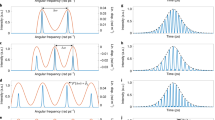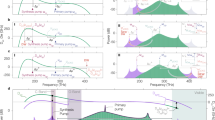Abstract
A method is proposed for relaxing the bandwidth restrictions due to dispersion in frequency mixing. An example for the third-harmonic generation of neodymium glass shows that it is possible to significantly reduce and even eliminate the effects of dispersion for the bandwidths required for femtosecond pulses.
Similar content being viewed by others
References
R. H. LEHMBERG, A. J. SCHMITT and S. F. BODNER,J. Appl. Phys. 62 (1987) 2680.
S. SKUPSKY, R. W. SHORT, T. KESSLER, R. S. CRAXTON, S. LETZRING and J. M. SOURES,J. Appl. Phys. 66 (1989) 3456.
E. M. CAMPBELL,Phys. Fluids B 4 (1992) 3781.
G. SZABÓ and Z. BOR,Appl. Phys. B 58 (1994) 237.
M. D. SKLEDON, R. S. CRAXTON, T. J. KESSLER, W. SEKA, R. W. SHORT, S. SKUPSKY and J. M. SOURES,IEEE J. Quantum Electron. 28 (1992) 1389.
A. C. L. BOSCHERON and C. J. SAUTERET, Mixing of chirped pulses for broadband harmonic generation,IAEA Technical Meeting, Paris, 1994.
Author information
Authors and Affiliations
Rights and permissions
About this article
Cite this article
Ross, I.N., Osvay, K. Efficient broad-bandwidth frequency mixing in dispersive media. Opt Quant Electron 28, 83–86 (1996). https://doi.org/10.1007/BF00578553
Received:
Revised:
Accepted:
Issue Date:
DOI: https://doi.org/10.1007/BF00578553




